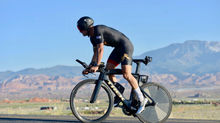Is It Ever Too Hot For an Aero Helmet?
- Jason Lentzke
- Jun 3, 2023
- 2 min read

It's been studied and proven that while your head's temperature increases during cycling in the heat with an aero-helmet compared to a traditional vented racing helmet during low and high-intensity cycling, the head temperature and HR responses are similar irrespective of helmet type. Furthermore, the increased head temperature that develops when an aero-helmet is worn during cycling in the heat does not affect power output or cycling performance during short-duration (12km TT), high-intensity events. However, what about riding 56-112 miles after swimming 2-4k? Craig Alexander & Mat Steinmetz tried to crack this code years ago. What they found was that perception is everything.
At what temperature is the aero helmet's reduction in wind resistance surpassed by the athlete's higher-level of thermal perceived exertion? There really is no definitive answer. Ultimately, it depends on how well acclimated you are to the conditions you are racing in and how well you can fuel at race intensity. Do not race in a helmet that you've never field-tested. It is entirely up to you to get comfortable with however warm or cool your aero helmet feels and what you can tolerate. Whether you're racing in the tropics or the UK, choose your aero helmet wisely by researching which helmet is fastest on your head based on your heat acclimation and bike position. Toro Performance professional athlete, Pablo Gomez, sums it up nicely:
"I am somebody that has had to test different helmets to accommodate my high sweat rate. My biggest takeaway has been that just because a helmet works for a World Champion and it is super fast in the wind tunnel, doesn't mean it is the best helmet for you. If you are looking for a race helmet, and you don't have access to a wind tunnel, do your research and look for helmets that generally test well with different athletes in independent wind tunnel tests, but also that have good reviews within the triathlon community. Look into reviews on heat perception, fogging/visor visibility, and how easy it is to put it on and take it off in transition. Also, don't be afraid to reach out to friends and training partners that might have a certain helmet, and give that helmet a go before you commit to purchase it.
Once you acquire your helmet, test it in training to make sure that your neck and back muscles are used to the differences in weight and form, but don't overdo it, leave some of that magic feeling of pure speed for the moment it matters, race day!"





























Comments